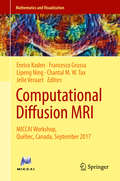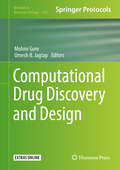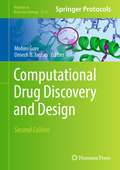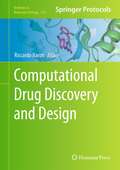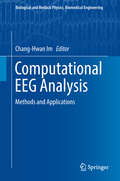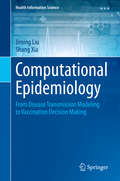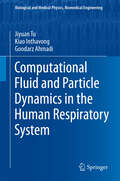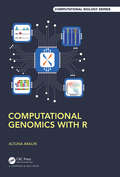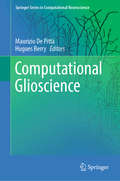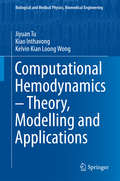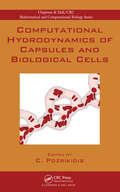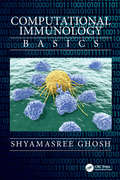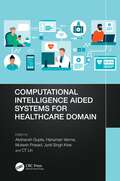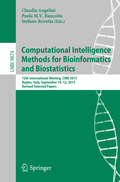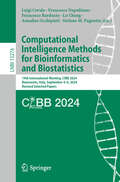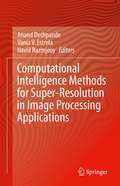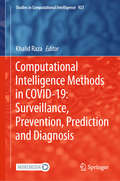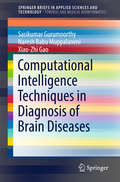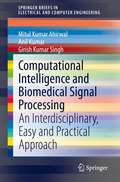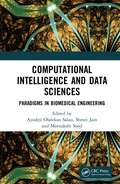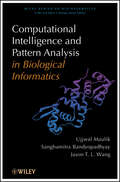- Table View
- List View
Computational Diffusion MRI: Miccai Workshop, Athens, Greece, October 2016 (Mathematics And Visualization Ser.)
by Enrico Kaden Francesco Grussu Lipeng Ning Chantal M. W. Tax Jelle VeraartThis volume presents the latest developments in the highly active and rapidly growing field of diffusion MRI. The reader will find numerous contributions covering a broad range of topics, from the mathematical foundations of the diffusion process and signal generation, to new computational methods and estimation techniques for the in-vivo recovery of microstructural and connectivity features, as well as frontline applications in neuroscience research and clinical practice.These proceedings contain the papers presented at the 2017 MICCAI Workshop on Computational Diffusion MRI (CDMRI’17) held in Québec, Canada on September 10, 2017, sharing new perspectives on the most recent research challenges for those currently working in the field, but also offering a valuable starting point for anyone interested in learning computational techniques in diffusion MRI. This book includes rigorous mathematical derivations, a large number of rich, full-colour visualisations and clinically relevant results. As such, it will be of interest to researchers and practitioners in the fields of computer science, MRI physics and applied mathematics.
Computational Drug Discovery and Design (Methods In Molecular Biology #1762)
by Mohini Gore Umesh B. JagtapThis volume details methods and techniques for identification of drug targets, binding sites prediction, high-throughput virtual screening,and prediction of pharmacokinetic properties using computer based methodologies. Chapters guide readers through techniques of the available computational tools, developing prediction models for drug target prediction and de novo design of ligands, structure based drug designing, fragment-based drug designing, molecular docking, and scoring functions for assessing protein-ligand docking protocols. Written in the highly successful Methods in Molecular Biology series format, chapters include introductions to their respective topics, lists of the necessary materials, step-by-step, readily reproducible protocols, and tips on troubleshooting and avoiding known pitfalls.Authoritative and cutting-edge, Computational Drug Discovery and Design aims to provide protocols for the use of bioinformatics tools in drug discovery and design.
Computational Drug Discovery and Design (Methods in Molecular Biology #2714)
by Mohini Gore Umesh B. JagtapThis second edition provides new and updated methods and techniques for identification of drug target, binding sites prediction, high- throughput virtual screening, lead discovery and optimization, conformational sampling, prediction of pharmacokinetic properties using computer-based methodologies. Chapters also focus on the application of the latest artificial intelligence technologies for computer aided drug discovery. Written in the format of the highly successful Methods in Molecular Biology series, each chapter includes an introduction to the topic, lists necessary methods, includes tips on troubleshooting and known pitfalls, and step-by-step, readily reproducible protocols. Authoritative and cutting-edge, Computational Drug Discovery and Design, Second Edition aims to effectively utilize computational methodologies in discovery and design of novel drugs.
Computational Drug Discovery and Design (Methods in Molecular Biology #819)
by Riccardo BaronDue to the rapid and steady growth of available low-cost computer power, the use of computers for discovering and designing new drugs is becoming a central topic in modern molecular biology and medicinal chemistry. In Computational Drug Discovery and Design: Methods and Protocols expert researchers in the field provide key techniques to investigate biomedical applications for drug developments based on computational chemistry. These include methods and techniques from binding sites prediction to the accurate inclusion of solvent and entropic effects, from high-throughput screening of large compound databases to the expanding area of protein-protein inhibition, toward quantitative free-energy approaches in ensemble-based drug design using distributed computing. Written in the highly successful Methods in Molecular BiologyTM series format, chapters include introductions to their respective topics, reference to software and open source analysis tools, step-by-step, readily reproducible computational protocols, and key tips on troubleshooting and avoiding known pitfalls. Thorough and intuitive, Computational Drug Discovery and Design: Methods and Protocols aids scientists in the continuing study of state-of-the-art concepts and computer-based methodologies.
Computational EEG Analysis: Methods and Applications (Biological and Medical Physics, Biomedical Engineering)
by Chang-Hwan ImThis book introduces and reviews all of the currently available methods being used for computational electroencephalogram (EEG) analysis, from the fundamentals through to the state-of-the-art. The aim of the book is to help biomedical engineers and medical doctors who use EEG to better understand the methods and applications of computational EEG analysis from a single, well-organized resource. Following a brief introduction to the principles of EEG and acquisition techniques, the book is divided into two main sections. The first of these covers analysis methods, beginning with preprocessing, and then describing EEG spectral analysis, event-related potential analysis, source imaging and multimodal neuroimaging, and functional connectivity analysis. The following section covers application of EEG analysis to specific fields, including the diagnosis of psychiatric diseases and neurological disorders, brain-computer interfacing, and social neuroscience. Aimed at practicing medical specialists, engineers, researchers and advanced students, the book features contributions from world-renowned biomedical engineers working across a broad spectrum of computational EEG analysis techniques and EEG applications.
Computational Epidemiology: From Disease Transmission Modeling to Vaccination Decision Making (Health Information Science)
by Jiming Liu Shang XiaThis book provides a comprehensive introduction to computational epidemiology, highlighting its major methodological paradigms throughout the development of the field while emphasizing the needs for a new paradigm shift in order to most effectively address the increasingly complex real-world challenges in disease control and prevention. Specifically, the book presents the basic concepts, related computational models, and tools that are useful for characterizing disease transmission dynamics with respect to a heterogeneous host population. In addition, it shows how to develop and apply computational methods to tackle the challenges involved in population-level intervention, such as prioritized vaccine allocation. A unique feature of this book is that its examination on the issues of vaccination decision-making is not confined only to the question of how to develop strategic policies on prioritized interventions, as it further approaches the issues from the perspective of individuals, offering a well integrated cost-benefit and social-influence account for voluntary vaccination decisions. One of the most important contributions of this book lies in it offers a blueprint on a novel methodological paradigm in epidemiology, namely, systems epidemiology, with detailed systems modeling principles, as well as practical steps and real-world examples, which can readily be applied in addressing future systems epidemiological challenges.The book is intended to serve as a reference book for researchers and practitioners in the fields of computer science and epidemiology. Together with the provided references on the key concepts, methods, and examples being introduced, the book can also readily be adopted as an introductory text for undergraduate and graduate courses in computational epidemiology as well as systems epidemiology, and as training materials for practitioners and field workers.
Computational Fluid and Particle Dynamics in the Human Respiratory System (Biological and Medical Physics, Biomedical Engineering)
by Goodarz Ahmadi Jiyuan Tu Kiao InthavongTraditional research methodologies in the human respiratory system have always been challenging due to their invasive nature. Recent advances in medical imaging and computational fluid dynamics (CFD) have accelerated this research. This book compiles and details recent advances in the modelling of the respiratory system for researchers, engineers, scientists, and health practitioners. It breaks down the complexities of this field and provides both students and scientists with an introduction and starting point to the physiology of the respiratory system, fluid dynamics and advanced CFD modeling tools. In addition to a brief introduction to the physics of the respiratory system and an overview of computational methods, the book contains best-practice guidelines for establishing high-quality computational models and simulations. Inspiration for new simulations can be gained through innovative case studies as well as hands-on practice using pre-made computational code. Last but not least, students and researchers are presented the latest biomedical research activities, and the computational visualizations will enhance their understanding of physiological functions of the respiratory system.
Computational Genomics with R (Chapman & Hall/CRC Computational Biology Series)
by Altuna AkalinComputational Genomics with R provides a starting point for beginners in genomic data analysis and also guides more advanced practitioners to sophisticated data analysis techniques in genomics. The book covers topics from R programming, to machine learning and statistics, to the latest genomic data analysis techniques. The text provides accessible information and explanations, always with the genomics context in the background. This also contains practical and well-documented examples in R so readers can analyze their data by simply reusing the code presented. As the field of computational genomics is interdisciplinary, it requires different starting points for people with different backgrounds. For example, a biologist might skip sections on basic genome biology and start with R programming, whereas a computer scientist might want to start with genome biology. After reading: You will have the basics of R and be able to dive right into specialized uses of R for computational genomics such as using Bioconductor packages. You will be familiar with statistics, supervised and unsupervised learning techniques that are important in data modeling, and exploratory analysis of high-dimensional data. You will understand genomic intervals and operations on them that are used for tasks such as aligned read counting and genomic feature annotation. You will know the basics of processing and quality checking high-throughput sequencing data. You will be able to do sequence analysis, such as calculating GC content for parts of a genome or finding transcription factor binding sites. You will know about visualization techniques used in genomics, such as heatmaps, meta-gene plots, and genomic track visualization. You will be familiar with analysis of different high-throughput sequencing data sets, such as RNA-seq, ChIP-seq, and BS-seq. You will know basic techniques for integrating and interpreting multi-omics datasets. Altuna Akalin is a group leader and head of the Bioinformatics and Omics Data Science Platform at the Berlin Institute of Medical Systems Biology, Max Delbrück Center, Berlin. He has been developing computational methods for analyzing and integrating large-scale genomics data sets since 2002. He has published an extensive body of work in this area. The framework for this book grew out of the yearly computational genomics courses he has been organizing and teaching since 2015.
Computational Glioscience (Springer Series in Computational Neuroscience)
by Maurizio De Pittà Hugues BerryOver the last two decades, the recognition that astrocytes - the predominant type of cortical glial cells - could sense neighboring neuronal activity and release neuroactive agents, has been instrumental in the uncovering of many roles that these cells could play in brain processing and the storage of information. These findings initiated a conceptual revolution that leads to rethinking how brain communication works since they imply that information travels and is processed not just in the neuronal circuitry but in an expanded neuron-glial network. On the other hand the physiological need for astrocyte signaling in brain information processing and the modes of action of these cells in computational tasks remain largely undefined. This is due, to a large extent, both to the lack of conclusive experimental evidence, and to a substantial lack of a theoretical framework to address modeling and characterization of the many possible astrocyte functions. This book that we propose aims at filling this gap, providing the first systematic computational approach to the complex, wide subject of neuron-glia interactions. The organization of the book is unique insofar as it considers a selection of “hot topics” in glia research that ideally brings together both the novelty of the recent experimental findings in the field and the modelling challenge that they bear. A chapter written by experimentalists, possibly in collaboration with theoreticians, will introduce each topic. The aim of this chapter, that we foresee less technical in its style than in conventional reviews, will be to provide a review as clear as possible, of what is “established” and what remains speculative (i.e. the open questions). Each topic will then be presented in its possible different aspects, by 2-3 chapters by theoreticians. These chapters will be edited in order to provide a “priming” reference for modeling neuron-glia interactions, suitable both for the graduate student and the professional researcher.
Computational Hemodynamics - Theory, Modelling and Applications (Biological and Medical Physics, Biomedical Engineering)
by Jiyuan Tu Kiao Inthavong Kelvin Kian Loong WongThis book discusses geometric and mathematical models that can be used to study fluid and structural mechanics in the cardiovascular system. Where traditional research methodologies in the human cardiovascular system are challenging due to its invasive nature, several recent advances in medical imaging and computational fluid and solid mechanics modelling now provide new and exciting research opportunities. This emerging field of study is multi-disciplinary, involving numerical methods, computational science, fluid and structural mechanics, and biomedical engineering. Certainly any new student or researcher in this field may feel overwhelmed by the wide range of disciplines that need to be understood. This unique book is one of the first to bring together knowledge from multiple disciplines, providing a starting point to each of the individual disciplines involved, attempting to ease the steep learning curve. This book presents elementary knowledge on the physiology of the cardiovascular system; basic knowledge and techniques on reconstructing geometric models from medical imaging; mathematics that describe fluid and structural mechanics, and corresponding numerical/computational methods to solve its equations and problems. Many practical examples and case studies are presented to reinforce best practice guidelines for setting high quality computational models and simulations. These examples contain a large number of images for visualization, to explain cardiovascular physiological functions and disease. The reader is then exposed to some of the latest research activities through a summary of breakthrough research models, findings, and techniques. The book's approach is aimed at students and researchers entering this field from engineering, applied mathematics, biotechnology or medicine, wishing to engage in this emerging and exciting field of computational hemodynamics modelling.
Computational Hydrodynamics of Capsules and Biological Cells (Chapman & Hall/CRC Computational Biology Series)
by C. PozrikidisSpanning biological, mathematical, computational, and engineering sciences, computational biofluiddynamics addresses a diverse family of problems involving fluid flow inside and around living organisms, organs, tissue, biological cells, and other biological materials. Computational Hydrodynamics of Capsules and Biological Cells provides a comprehen
Computational Immunology: Applications
by Shyamasree GhoshComputational Immunology: Applications focuses on different mathematical models, statistical tools, techniques, and computational modelling that helps in understanding complex phenomena of the immune system and its biological functions. The book also focuses on the latest developments in computational biology in designing of drugs, targets, biomarkers for early detection and prognosis of a disease. It highlights the applications of computational methods in deciphering the complex processes of the immune system and its role in health and disease. This book discusses the most essential topics, including Next generation sequencing (NGS) and computational immunology Computational modelling and biology of diseases Drug designing Computation and identification of biomarkers Application in organ transplantation Application in disease detection and therapy Computational methods and applications in understanding of the invertebrate immune system Shyamasree Ghosh (MSc, PhD, PGDHE, PGDBI) Scientific Officer (F), is currently working in the School of Biological Sciences, National Institute of Science Education and Research (NISER), Bhubaneswar, DAE, Govt of India, graduated from the prestigious Presidency College Kolkata in 1998. She was awarded the prestigious National Scholarship from the Government of India. She has worked and published extensively in glycobiology, sialic acids, immunology, stem cells and nanotechnology. She has authored several publications that include books and encyclopedia chapters in reputed journals and books.
Computational Immunology: Basics
by Shyamasree GhoshThe immune system is highly complex system with large number of macromolecules, signaling pathways, protein-protein interactions, and gene expressions. Studies from genomics, transcriptomics, metabolomics are generating huge high throughput data that needs to be analyzed for understanding the Immune system in Health and Disease. Computational approaches arehelping in understanding the study of complex biology of immunology and thereby enabling design of therapeutic strategies in diseases like infectious diseases, immunodeficiency, allergic, hypersensitive, autoimmune disorders and diseases like Cancer, HIV etc. Computational Immunology: Basics highlights the basics of the immune system and function in health and disease. This book offers comprehensive coverage of the most essential topics, including Overview of Immunology and computational Immunology Immune organs and cells, antigen, antibody, B, cell, T cell Antigen Processing and presentation Diseases due to abnormalities of the immune system Cancer Biology Shyamasree Ghosh (MSc, PhD, PGDHE, PGDBI), is currently working in the School of Biological Sciences, National Institute of Science Education and Research (NISER), Bhubaneswar, DAE, Govt of India, graduated from the prestigious Presidency College Kolkata in 1998. She was awarded the prestigious National Scholarship from the Government of India. She has worked and published extensively in glycobiology, sialic acids, immunology, stem cells and nanotechnology. She has authored several publications that include books and encyclopedia chapters in reputed journals and books.
Computational Intelligence Aided Systems for Healthcare Domain
by Akshansh GuptaThis book covers recent advances in artificial intelligence, smart computing, and their applications in augmenting medical and health care systems. It will serve as an ideal reference text for graduate students and academic researchers in diverse engineering fields including electrical, electronics and communication, computer, and biomedical. This book- Presents architecture, characteristics, and applications of artificial intelligence and smart computing in health care systems. Highlights privacy issues faced in health care and health informatics using artificial intelligence and smart computing technologies. Discusses nature-inspired computing algorithms for the brain-computer interface. Covers graph neural network application in the medical domain. Provides insights into the state-of-the-art artificial intelligence and smart computing enabling and emerging technologies. This book discusses recent advances and applications of artificial intelligence and smart technologies in the field of healthcare. It highlights privacy issues faced in health care and health informatics using artificial intelligence and smart computing technologies. It covers nature-inspired computing algorithms such as genetic algorithms, particle swarm optimization algorithms, and common scrambling algorithms to study brain-computer interfaces. It will serve as an ideal reference text for graduate students and academic researchers in the fields of electrical engineering, electronics and communication engineering, computer engineering, and biomedical engineering.
Computational Intelligence Methods for Bioinformatics and Biostatistics: 12th International Meeting, CIBB 2015, Naples, Italy, September 10-12, 2015, Revised Selected Papers (Lecture Notes in Computer Science #9874)
by Stefano Rovetta Claudia Angelini Paola M. V. RancoitaThis book constitutes the thoroughly refereed post-conference proceedings of the 12th International Meeting on Computational Intelligence Methods for Bioinformatics and Biostatistics, CIBB 2015, held in Naples, Italy, in September, 2015. The 21 revised full papers presented were carefully reviewed and selected from 24 submissions. They present problems concerning computational techniques in bioinformatics, systems biology and medical informatics discussing cutting edge methodologies and accelerate life science discoveries, as well as novel challenges with an high impact on molecular biology and translational medicine.
Computational Intelligence Methods for Bioinformatics and Biostatistics: 18th International Meeting, CIBB 2023, Padova, Italy, September 6–8, 2023, Revised Selected Papers (Lecture Notes in Computer Science #14513)
by Erica Tavazzi Enrico Longato Martina Vettoretti Giacomo Baruzzo Massimo BellatoThe book constitutes the refereed post-conference proceedings of the 18th International Meeting on Computational Intelligence Methods for Bioinformatics and Biostatistics, CIBB 2023, held in Padova, Italy, during September 6–8, 2023. The 23 full papers presented in these proceedings were carefully reviewed and selected from 24 submissions. They focuses on topics such as machine learning in healthcare informatics and medical biology; machine learning explainability in medical imaging; prediction uncertainty in machine learning; advanced statistical and computational methodologies for single-cell omics data; present and future research in bioinformatics; distributed computing in bioinformatics and computational biology; and modelling and simulation methods for computational biology and systems medicine.
Computational Intelligence Methods for Bioinformatics and Biostatistics: 19th International Meeting, CIBB 2024, Benevento, Italy, September 4–6, 2024, Revised Selected Papers (Lecture Notes in Computer Science #15276)
by Luigi Cerulo Francesco Napolitano Francesco Bardozzo Lu Cheng Annalisa Occhipinti Stefano M. PagnottaThis volume LNCS 15276 constitutes the revised selected papers of the 19th International Meeting on Computational Intelligence Methods for Bioinformatics and Biostatistics, CIBB 2024, held in Benevento, Italy, during September 4–6, 2024. The 24 full papers and 3 short papers were carefully reviewed and selected from 28 submissions. They were organized in the following topical sections: Bioinformatics; Medical Informatics; Natural Language Processing (NLP) and Large Language Models (LLM) for Unstructured Data in Health Informatics; Modeling and Simulation Methods for Computational Biology and Systems Medicine; Machine Learning for Structured Data in Clinical Informatics and Medical Biology; Computational Intelligence in Personalized Medicine; and Computational Structural Bioinformatics.
Computational Intelligence Methods for Super-Resolution in Image Processing Applications
by Anand Deshpande Navid Razmjooy Vania V. EstrelaThis book explores the application of deep learning techniques within a particularly difficult computational type of computer vision (CV) problem ─ super-resolution (SR). The authors present and discuss ways to apply computational intelligence (CI) methods to SR. The volume also explores the possibility of using different kinds of CV techniques to develop and enhance the tools/processes related to SR. The application areas covered include biomedical engineering, healthcare applications, medicine, histology, and material science. The book will be a valuable reference for anyone concerned with multiple multimodal images, especially professionals working in remote sensing, nanotechnology and immunology at research institutes, healthcare facilities, biotechnology institutions, agribusiness services, veterinary facilities, and universities.
Computational Intelligence Methods in COVID-19: Surveillance, Prevention, Prediction and Diagnosis (Studies in Computational Intelligence #923)
by Khalid RazaThe novel coronavirus disease 2019 (COVID-19) pandemic has posed a major threat to human life and health. This book is beneficial for interdisciplinary students, researchers, and professionals to understand COVID-19 and how computational intelligence can be used for the purpose of surveillance, control, prevention, prediction, diagnosis, and potential treatment of the disease. The book contains different aspects of COVID-19 that includes fundamental knowledge, epidemic forecast models, surveillance and tracking systems, IoT- and IoMT-based integrated systems for COVID-19, social network analysis systems for COVID-19, radiological images (CT, X-ray) based diagnosis system, and computational intelligence and in silico drug design and drug repurposing methods against COVID-19 patients. The contributing authors of this volume are experts in their fields and they are from various reputed universities and institutions across the world. This volume is a valuable and comprehensive resource for computer and data scientists, epidemiologists, radiologists, doctors, clinicians, pharmaceutical professionals, along with graduate and research students of interdisciplinary and multidisciplinary sciences.
Computational Intelligence Techniques for Combating COVID-19 (EAI/Springer Innovations in Communication and Computing)
by Sheng-Lung Peng Sandeep Kautish Ahmed J. ObaidThis book presents the latest cutting edge research, theoretical methods, and novel applications in the field of computational intelligence and computational biological approaches that are aiming to combat COVID-19. The book gives the technological key drivers behind using AI to find drugs that target the virus, shedding light on the structure of COVID-19, detecting the outbreak and spread of new diseases, spotting signs of a COVID-19 infection in medical images, monitoring how the virus and lockdown is affecting mental health, and forecasting how COVID-19 cases and deaths will spread across cities and why. Further, the book helps readers understand computational intelligence techniques combating COVID-19 in a simple and systematic way.
Computational Intelligence Techniques in Diagnosis of Brain Diseases (SpringerBriefs in Applied Sciences and Technology)
by Xiao-Zhi Gao Naresh Babu Muppalaneni Sasikumar GurumoorthyThis book highlights a new biomedical signal processing method of extracting a specific underlying signal from possibly noisy multi-channel recordings, and shows that the method is suitable for extracting independent components from the measured electroencephalogram (EEG) signal. The system efficiently extracts memory spindles and is also effective in Alzheimer seizures. Current developments in computer hardware and signal processing have made it possible for EEG signals or "brain waves" to communicate between humans and computers - an area that can be extended for use in this domain.
Computational Intelligence and Big Data Analytics: Applications in Bioinformatics (SpringerBriefs in Applied Sciences and Technology)
by Ch. Satyanarayana Kunjam Nageswara Rao Richard G. BushThis book highlights major issues related to big data analysis using computational intelligence techniques, mostly interdisciplinary in nature. It comprises chapters on computational intelligence technologies, such as neural networks and learning algorithms, evolutionary computation, fuzzy systems and other emerging techniques in data science and big data, ranging from methodologies, theory and algorithms for handling big data, to their applications in bioinformatics and related disciplines. The book describes the latest solutions, scientific results and methods in solving intriguing problems in the fields of big data analytics, intelligent agents and computational intelligence. It reflects the state of the art research in the field and novel applications of new processing techniques in computer science. This book is useful to both doctoral students and researchers from computer science and engineering fields and bioinformatics related domains.
Computational Intelligence and Biomedical Signal Processing: An Interdisciplinary, Easy and Practical Approach (SpringerBriefs in Electrical and Computer Engineering)
by Anil Kumar Mitul Kumar Ahirwal Girish Kumar SinghThis book presents an interdisciplinary paradigms of computational intelligence techniques and biomedical signal processing. The computational intelligence techniques outlined in the book will help to develop various ways to enhance and utilize signal processing algorithms in the field of biomedical signal processing. In this book, authors have discussed research, discoveries and innovations in computational intelligence, signal processing, and biomedical engineering that will be beneficial to engineers working in the field of health care systems. The book provides fundamental and initial level theory and implementation tools, so that readers can quickly start their research in these interdisciplinary domains.
Computational Intelligence and Data Sciences: Paradigms in Biomedical Engineering
by Ayodeji Olalekan Salau, Shruti Jain, Meenakshi SoodThis book presents futuristic trends in computational intelligence including algorithms as applicable to different application domains in health informatics covering bio-medical, bioinformatics, and biological sciences. Latest evolutionary approaches to solve optimization problems under biomedical engineering field are discussed. It provides conceptual framework with a focus on application of computational intelligence techniques in the domain of biomedical engineering and health informatics including real-time issues.
Computational Intelligence and Pattern Analysis in Biology Informatics
by Ujjwal Maulik Jason T. Wang Sanghamitra BandyopadhyayAn invaluable tool in Bioinformatics, this unique volume provides both theoretical and experimental results, and describes basic principles of computational intelligence and pattern analysis while deepening the reader's understanding of the ways in which these principles can be used for analyzing biological data in an efficient manner.This book synthesizes current research in the integration of computational intelligence and pattern analysis techniques, either individually or in a hybridized manner. The purpose is to analyze biological data and enable extraction of more meaningful information and insight from it. Biological data for analysis include sequence data, secondary and tertiary structure data, and microarray data. These data types are complex and advanced methods are required, including the use of domain-specific knowledge for reducing search space, dealing with uncertainty, partial truth and imprecision, efficient linear and/or sub-linear scalability, incremental approaches to knowledge discovery, and increased level and intelligence of interactivity with human experts and decision makersChapters authored by leading researchers in CI in biology informatics.Covers highly relevant topics: rational drug design; analysis of microRNAs and their involvement in human diseases.Supplementary material included: program code and relevant data sets correspond to chapters.
